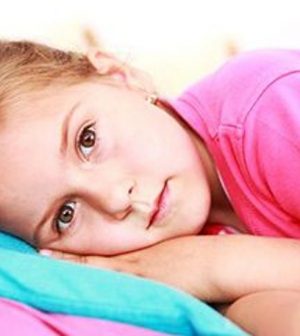- Navigating Your Midlife Crisis: Embracing New Possibilities
- City Raccoons Showing Signs of Domestication
- Mapping the Exposome: Science Broadens Focus to Environmental Disease Triggers
- One Week Less on Social Media Linked to Better Mental Health
- Your Brain Changes in Stages as You Age, Study Finds
- Some Suicide Victims Show No Typical Warning Signs, Study Finds
- ByHeart Formula Faces Lawsuits After Babies Sickened With Botulism
- Switch to Vegan Diet Could Cut Your Greenhouse Gas Emissions in Half
- Regular Bedtime Does Wonders for Blood Pressure
- Dining Alone Could Mean Worse Nutrition for Seniors
Sleepless Children Often Become Sleepless Adults: Study

Young children who struggle with insomnia face a very high risk for more of the same as young adults, a new study warns.
Investigators found that 43% of children who suffer from insomnia between the ages of 5 and 12 continue to do so when they hit their 20s and 30s.
And that amounts to a near tripling of the risk that a sleep-deprived child will end up becoming a sleep-deprived adult, the researchers said.
That’s “much higher than previously believed,” said study lead author Julio Fernandez-Mendoza. He is an associate professor of psychiatry and behavioral health with the Sleep Research & Treatment Center at Penn State University College of Medicine.
In the study, he and his colleagues pointed out that childhood insomnia is not uncommon.
“About 20% to 25% of school-aged children have insomnia symptoms, understood as difficulties falling or staying asleep,” Fernandez-Mendoza noted. Among adolescents, that figure rises to between 35% and 40%.
There are many reasons why, he noted, with genetic predisposition playing a relatively minor role, alongside medical, behavioral and environmental factors.
Specifically, that could mean underlying gastrointestinal issues or headaches; a “stressful” home or neighborhood environment; poverty or discrimination; or poor sleep habits, such as the regular use of electronic devices in bed.
To explore the persistence of insomnia among kids as they grow up, the team tracked just over 500 children as they aged from as young as 5 to as old as 31.
During the first phase of the study — conducted between 2000 and 2005 — all the kids (and/or their parents) completed questionnaires regarding their sleep. Sleep habits were also tracked in real time during sleepovers held in a laboratory setting.
Nearly one-quarter of the pre-adolescent kids were deemed to have insomnia.
Somewhere between 6 to 13 years later, most of the kids underwent the same assessments as teens, at an average age of 16. More than one-third (36%) of the adolescents were then found to be battling insomnia.
A third assessment phase was then conducted in the form of a follow-up sleep survey launched between 2018 and 2021. At that time, the average age of the study participants was 24.
The team found that about 27% of pre-adolescent insomniacs had become healthy sleepers as adults. About 11% of those who had still struggled with sleep as adolescents also managed to leave insomnia behind by the time they’d reached their 20s and early 30s.
But nearly 19% of those with a history of sleep trouble as children had continued to experience intermittent insomnia as adolescents and adults, while more than four in 10 continued to be plagued by persistent sleep deprivation.
The findings, said Fernandez-Mendoza, underscore the importance of addressing insomnia at a young age, to prevent the development of a lifelong problem.
In many cases that can take the form of cognitive behavioral therapy, to address bad sleep habits such as “using electronics or watching TV in bed, worrying in bed, sleeping in on weekends, [or] napping during the day, among many others,” he said. This type of intervention has long been used to help adults, he noted, “and is gaining greater evidence and support in youth, particularly adolescents.”
On the other hand, when tackling pediatric insomnia, Fernandez-Mendoza cautioned that “sleep medications should always be a second-line treatment. And melatonin should only be used in very specific cases, despite its widespread and incorrect use.”
The findings were published online Feb. 17 in the journal Pediatrics.
“Parents can start with healthy sleep habits in infancy,” advised Dr. Carey Lockhart. She’s a clinical associate professor in the department of neurology and department of pulmonology and sleep medicine at Seattle Children’s Hospital.
“Developing a consistent and calming bedtime routine that is maintained throughout childhood — and teaching healthy sleep habits such as no screens in the bedroom or right before bedtime — can create a stable routine and strong sleep health foundation,” said Lockhart, who was not involved in the study.
“Parents can also help teach adolescents time management skills early on,” she added, “so that teenagers learn, for example, to do homework during the day rather than in the night time hours, which can result in delayed bedtimes.”
Such efforts can go a long way towards shaping and improving sleeping habits at a young age, said Lockhart, so that “children and adolescents may have less likelihood of insomnia persisting to adulthood.”
More information
There’s more about teens and sleep at UCLA Health.
SOURCES: Julio Fernandez-Mendoza, PhD, associate professor, psychiatry and behavioral health, Sleep Research & Treatment Center, Penn State University College of Medicine, Hershey, Pa.; Carey Lockhart, MD, clinical associate professor, department of neurology and department of pulmonology and sleep medicine, Seattle Children’s Hospital; Pediatrics, Feb. 17, 2022, online
Source: HealthDay
Copyright © 2025 HealthDay. All rights reserved.










